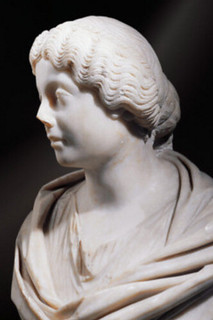
PREV ARTICLE
NEXT ARTICLE
FULL ISSUE
PREV FULL ISSUE
HAIRDRESSING ARCHAEOLOGIST JANET STEPHENSSo how does one become a Hairdressing Archaeologist? With lots of reading, research and practice. Here's some background on Janet Stephens, the woman responsible for the
recreation of ancient hairstyles. First, here's an excerpt from a paper she published in 2008 in the Journal of Roman Archaeology. -Editor
Virtually all commentators demonstrate modern technological biases that lead to anachronistic speculation: in both looking at images and interpreting literary passages, they assume that the Romans used the same hairdressing technologies as do moderns. In addition, not being hairdressers, they fail to understand the technical possibilities of the tools that the Romans did have at their disposal. I will analyze the physical capabilities of the single prong hair-pin in order to show the impossibility of its application in many contexts. As an alternative I will propose sewing needles, arguing that, as Roman women of the 1st c. A.D. abandoned vitta-based [(vittae were linen or woollen ribbons used to tie the hair together when arranging it)] coiffures in favor of more elaborate fashions, they used needles (artifacts well attested in antiquity) invisibly to stitch together the style’s various components. From a May 28, 2013 Smithsonian Magazine article. -Editor
It’s easy to look back on fashions and hairstyles of yesterday and think, “What?” (Or perhaps, more honestly, “Why?”) But one woman is more interested in the “how.” As in: “How did Roman women make their hair look like that?” Meet Janet Stephens, a hairdresser from Baltimore. Like a superhero of the coiffe, she spends her days as a regular hair dresser, giving people layers and funky bobs. But at home, in her secret hair lair (okay, really just her basement) she attempts to recreate the hairstyles of ancient Rome. Her YouTube channel boasts all sorts of ancient hairstyles, from the Empress Plotina to Cleopatra’s coin hair. Her first foray into YouTube, published two years ago, recreated the empress Julia Domna’s hair using tools that the Romans would have had. But Stephens doesn’t just recreate these do’s for YouTube. She also publishes about her research in scientific journals. One paper, called Ancient Roman hairdressing: on (hair)pins and needles, described the difficulties and tools required to recreate Roman hairdos. Many historians had assumed that ancient women depicted with gravity defying curls, bumps and buns were wearing wigs. But, as Stephens told The Wall Street Journal, when she first heard the wig theory, she wasn’t sold: Through trial and error she found that she could achieve the hairstyle by sewing the braids and bits together, using a needle. She dug deeper into art and fashion history books, looking for references to stitching. In 2005, she had a breakthrough. Studying translations of Roman literature, Ms. Stephens says, she realized the Latin term “acus” was probably being misunderstood in the context of hairdressing. Acus has several meanings including a “single-prong hairpin” or “needle and thread,” she says. Translators generally went with “hairpin.” And the journals quickly recognized her expertise. John Humphrey, the editor of the Journal of Roman Archaeology told the Wall Street Journal: ”I could tell even from the first version that it was a very serious piece of experimental archaeology which no scholar who was not a hairdresser—in other words, no scholar—would have been able to write.” To read the complete article, see: But it all starts with a passion. Here's an interview from The History Blog: -Editor
Q: How did you first begin to research ancient hairdressing?
Q: When was the first time you tried to recreate a look and how successful was that initial foray? A: I think it was my first day off after that visit! I pulled out a long haired mannikin to try out Julia Domna, type 2. I made it as far as the serpentine bun and hit a wall. Bobby pins and hair pins just wouldn’t do the job. It was all library leg work and practical experimentation after that. Q: Your article in the JRA demonstrates an astonishingly thorough command of the archaeological record, and of primary and secondary sources relating to Roman hairstyling (and not just Roman, but also Etruscan and Greek). How did you master such a density of material? A: Lots and lots of reading, poring over exhibition catalogs, back searching the footnotes to the reading and reading some more! It helped that I am fluent in Italian and, in 2006, I took a German for reading class. Working in my spare time, the research took 6 years. Q: Did you do all this research on your own or through a school or other institution or …? A: I am an independent researcher, but my husband is a professor of Italian at the Johns Hopkins University, so I have library privileges there. We are friendly with colleagues in the Classics/Archaeology department and at the Walters Art Museum. They were kind enough to send me articles and clippings, read drafts and help with some picky Latin, though I try not to impose. To read the complete article, see: Here's an excerpt from a December 10, 2015 piece in New York magazine. -Editor
Stephens made her hypothesis known at the American Institute of Archaeology’s 2012 annual meeting. She brought with her a crude homemade poster and four mannequin heads on stakes to demonstrate that Julia Domna may have been going bald, not wearing wigs. The academy, schooled again. “I was mobbed,” said Stephens. “I felt like a rock star.” She had found her groupies. At the same AIA meeting in 2013, she presented a poster on the seni crines, the six-braided and cloth-covered hairstyle of the Vestal Virgins, gaining recognition from The Wall Street Journal. Stephens is the first known person in the modern world to re-create the hairstyle. The corresponding YouTube video has over 101,000 views. Stephens’s most loyal fans, however, find her not at academic conferences, but in their bedrooms on YouTube. Her discoveries have been a windfall to the ancient Rome-obsessed pockets of the internet. Her dissertation on wigs, for example, brought a much-needed confirmation to online history nerds that experts had been misapplying literary examples to real people for centuries. To read the complete article, see: Count me among your fans, Janet! -Editor
To read the earlier E-Sylum articles, see:  Wayne Homren, Editor The Numismatic Bibliomania Society is a non-profit organization promoting numismatic literature. See our web site at coinbooks.org. To submit items for publication in The E-Sylum, write to the Editor at this address: whomren@gmail.com To subscribe go to: https://my.binhost.com/lists/listinfo/esylum All Rights Reserved. NBS Home Page Contact the NBS webmaster 
|

